Everbody loves salad, especially Japanese salad.
The universal appeal of Japanese salad has made it a crowd favorite worldwide, and this recipe is no exception.
This triple mushroom salad is perfect for Sunday dinner, weekend brunch and almost in any occasion.
Why. Because it is so easy to prepare.
The salad is dressed with an umami-rich tonkatsu sauce and Japanese mayonnaise. The crispy vegetables and the exquisite Asian ingredients deliver a delicate balance of flavor and texture.
You have to taste this salad to be believed!
Here is the complete guide to show you how to prepare this delicious dish, step-by-step.
I know it is difficult to approximate restaurant-favorites at home. However, this wildly luxurious salad served in my restaurant can be easily prepared in minutes once you have got all the ingredients ready.

Note: This recipe is developed by my restaurant partner, Chef Jason Tan. He has worked in hotel banquet and Japanese restaurant for many years.
Note: This post may contain affiliate links. Please read my disclosure for more into. I may receive commissions for purchases made through links in this post.
Choose the best ingredients for this amazing Japanese salad
Here is the summary of how to prepare this salad:
- Use a variety of crisp vegetables (lettuce is preferred) to form the base of the salad.
- Place the shimeji, enoki and shitake mushrooms on top of the vegetables.
- Add a few slices of Japanese cucumber and cherry tomatoes.
- Decorate with some finely shredded carrots and purple cabbage.
- Use katsuobushi for the savory flavor. (No anchovies, please. This is not Caesar salad!)
- Dress the salad with tonkatsu sauce and Japanese mayonnaise.
- Serve along ith fried onion slices.
Let’s break down and discuss each ingredient in details.
1. Lettuce is the foundation of the salad
I will prefer to have a mixutre of iceberg for crunchiness, arugula for bitter and peppery, butterhead for its sweet flavor, and Romaine for its bitterness and creepiness.
You can buy the ready made, loose bag lettuce which has a mix of everything. If you are preparing for a larger portion, buy the vegetables separately and prepare it as below:
- – Tear the large pieces into smaller one by hand. Separate the leaves from the core.
– This step minimizes bruising and helps to maintain the crunchiness of the greens.
Wash and rinse it. - – Put the greens in a large bowl. Swish green with plenty of cold water.
– The dirt and small debris will loosen from the greens, which will sink to the bottom. The greens will float to the surface which can be removed easily. - – Remove the water from lettuce
– LIft the lettuce from water by hand. Do not pour the lettuce along with the water as the debris and dirt are in the water.
– Put the lettuce in a colander. - Place the lettuce on paper towel. Roll up the paper towels to dry the lettuce as much as possible.
- Storage:
– Place some paper towels at the bottom of a plastic container.
– Put the lettuce into a bowl. Cover the lettuce with a piece of paper towel to absorb any remaining water. Close the lid.
– Place the lettuce in the crisper drawer of the refrigerator.
– Lettuce store in this way can last for several days.
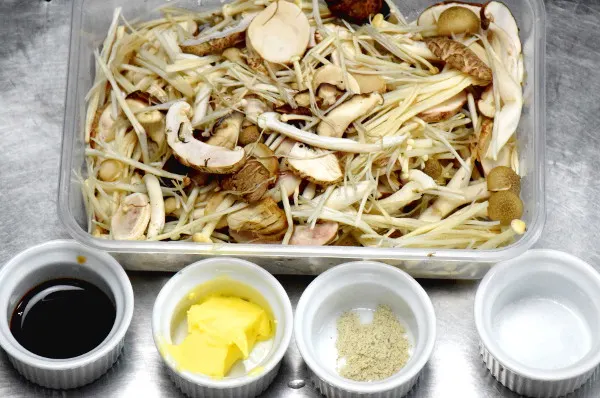
2. Japanese mushrooms add the savory umami to the salad
I use the combination of enoki, shitake and shimeji mushrooms in this recipe, making it much more flavorful than many other similar salad.
These mushrooms are widely popular in Asia. The combination of the three has an interesting mix of shapes and flavors. You can use other types of mushrooms that are available at where you stay, but I recommend to use at least some of these to keep the authenticity of the Asian flavor.
- Enoki has a delicate flavor. You need to trim off the root end of the cluster, separate each mushroom before sautéing. It has a mild flavor but a crunchy texture.
- Shiitake mushroom has a meaty texture. It has an earthy and smoky flavor. I prefer to cut the shiitake mushroom into thin pieces.
- Shimeji mushrooms have a sharp umami flavor and a piquant aroma. The firm chewy texture softens when cooked.
The mushrooms are sauteed with butter, seasoned with Japanese soy sauce salt and black pepper.
Read on after the image to find out how to use the other ingredients to build up this exquisite salad.
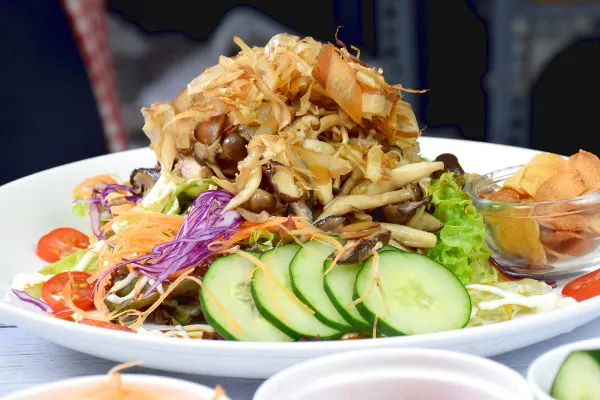
3. Cucumbers and tomatoes
After you have laid the lettuce as the foundation of the Japanese salad, you can add other vegetables with different shapes and colors.
- Japanese cucumber is long and slender and has less seed over regular cucumbers. It is also not bitter and entirely edible. Therefore, it is excellent for salad and sandwiches. I cut the cucumber lengthwise into thin slices in this recipe.
- Cherry tomato slices have a bright color and a very appealing pattern. I place it on the side of the plate to enhance the color and brighten up the salad.
4. Use shredded carrots and purple cabbage to garnish the salad
- Cut the carrots and purple cabbage into very fine strips. To achieve this, you can use a high-quality mandolin to cut it. The Japanese Mandolin brand Benriner can cut the vegetables into the fine, medium and coarse strips with ease. It also has the flexible thickness adjustment between 0.3mm to 5.0 mm.
- Purple cabbage has a bitter and sharp taste, and carrot is crunchy and sweet. You can now picture how the flavor of various vegetables intertwines with each other in this Japanese salad.
5. Katsuobushi has a strong savory flavor
- Katsuobushi is also called dry bonito flakes. It has a savory taste that is the foundation of most of the Japanese cooking. Katsuobushi is usually sprinkled on top of rice, noodles, and vegetables to add the umami flavor.
6. Tonkatsu sauce and mayonnaise is superior over French dressing
I used tonkatsu sauce and Japanese mayonnaise for the umami and creamy flavor.
So I reserve my French dressing for my other salads. (Just not because it is not good!)
- Japanese mayonnaise is different from the American counterpart as it does not add water in the process of making it. Instead, it includes apples as part of the ingredients. (Note that apples are commonly used in Japanese cuisine. For example, I add some apple when I prepare Japanese curry.) Japanese mayonnaise also uses only egg yolks rather than the whole eggs to prepare and has a thicker texture.
The question is, is it OK to use American mayonnaise as the substitute? Since now you know the difference, I will let you decide which one to use, as both are delicious and compatible with all the ingredients. - Tonkatsu sauce is used to serve with tonkatsu, a type of Japanese deep fried pork cutlet. However, it is also used in other Japanese cuisines extensively such as hambagu, other deep fried dishes, and Japanese salad. The sauce is essentially a mixture of tomato ketchup, Worcestershire sauce, and Japanese soy sauce. Some recipe also includes mirin and Dijon mustard.You may just make do with Worcestershire sauce if you think it is too much work to prepare the tonkatsu sauce. However, ready-made tonkatsu sauce is available readily in many countries which I bet you should be able to get it easily.
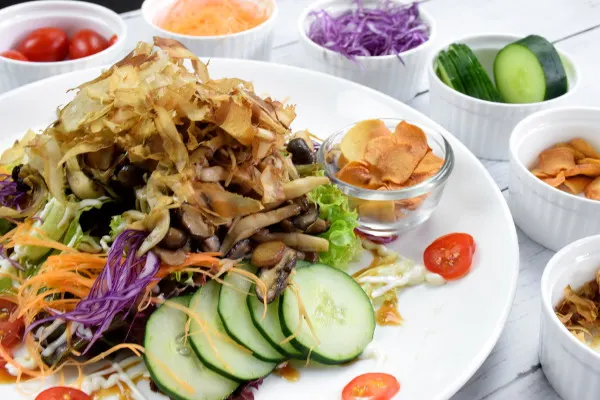
Japanese salad variation- with eggs and karaage
What if you do not like mushrooms, or simply want something different? No problem.
Chef Jason has immediately created another Japanese salad with hard-boiled eggs and karaage.
Karaage is the Japanese version of Chinese fried chicken marinated with soy sauce, rice wine, and mirin. You can find our recipe here.
Hard-boiled eggs are delicious if you do it correctly. Check out our blog post ‘How to cook the perfect hard boiled eggs‘. Otherwise, on onzen tamago (Japanese soft boiled egg is equally attractive.).
Here is how the salad with eggs and karaage looks like.
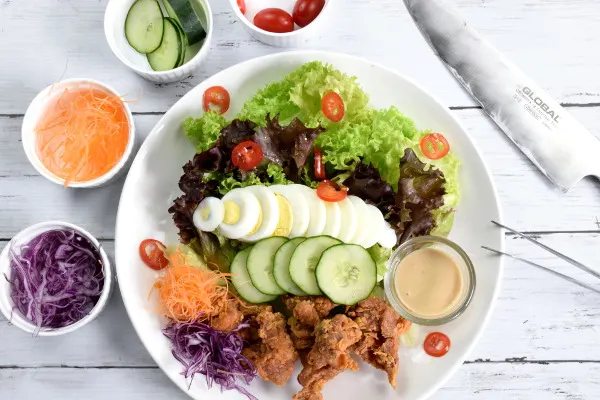
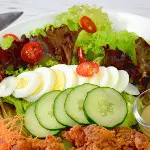
Japanese style mushroom salad
This recipe is developed by chef Jason Tan, a trained chef who has worked in hotel banquet, Taiwanese restaurant, and Japanese fine dining restaurant.
Ingredients
For sauteing the mushroom
- 30 g Enoki mushrooms
- 30 g Shimeiji mushrooms
- 30 g Shitake mushrooms
- 1/2 teaspoon Japanese soy sauce
- 15 g butter
- 1/8 teaspoon of salt
- A pinch of black pepper
To assemble the salad
- 100 g of Lettuce of your choice, e.g. butterhead, Romaine
- 15 ml Tonkatsu sauce
- 15 ml Japanese mayonnaise
- 1 Cherry tomatoes, sliced
- 6 slices Japanese cucumbers
- Purple cabbage, shredded
- Carrot, shredded
- Katsuobushi
- Japanese fried garlic, optional
Instructions
For the mushroom
- Cut the enoki mushroom about 2.5cm from the roots.
- Cut the shmeiji mushroom about 2cm from the roots.
- Cut the shitake mushroom into thin slices.
- Heat up the butter in a wok or pan.
- Saute the mushrooms with salt and pepper until fragrant.
- Add the soy sauce to the mushrooms. Dish out.
To Assemble to salad
- Place the lettuce at the center of a plate.
- Add the sauteed mushroom on top of the lettuce.
- Squeeze about one tablespoon each of tonkatsu sauce and Japanese mayonnaise on the mushrooms and lettuce.
- Arrange the Japanese cucumber and cherry at the side of the plate.
- Garnish with shredded carrot and purple cabbage.
- Top with katsuobushi.
- Serve with some fried garlic (optional).
Recommended Products
As an Amazon Associate and member of other affiliate programs, I earn from qualifying purchases.
Nutrition Information:
Yield: 1 Serving Size: 1Amount Per Serving: Calories: 548Total Fat: 30gSaturated Fat: 10gTrans Fat: 1gUnsaturated Fat: 16gCholesterol: 54mgSodium: 1306mgCarbohydrates: 63gFiber: 25gSugar: 27gProtein: 20g
This data was provided and calculated by Nutritionix on 5/25/2019


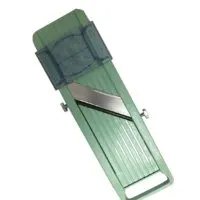
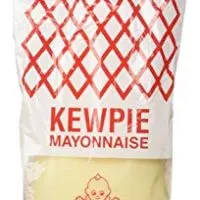
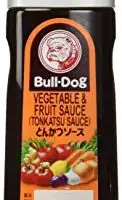
KP Kwan
Tuesday 25th of July 2017
Hi, this is KP Kwan. I am happy to see you in this comment area, as you have read through my recipe. I am glad to reply any questions and comments as soon as possible.